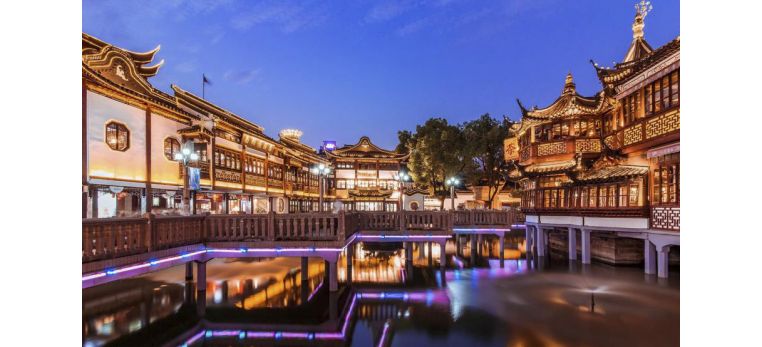
Built in Yongle Reign of Ming Dynasty (1368 - 1644), the Old City God Temple of Shanghai, commonly known as Chenghuangmiao by locals, is located at Middle Fangbang Road, and adjoins Yu Garden in the south. With the commercial development, and the surrounding trade region expanding, the numbers of shopping centers and snack streets are increasing rapidly. As a result, today's Old City God Temple usually refers to an area stretching from Anren Street in the east, to Fuyou Road in the north and Old Xiaochang Road westward. Yu Garden, Yuyuan Bazaar, Old Street and Chenxiang Pavilion all belong to this zone.
Old City God Temple enjoys a high status in Shanghai, with an old saying: one who fails to reach the temple never reaches Shanghai. City God Temple was built to protect the safety of the people in the city, and the gods are regarded as patron saints in Taoism.
The Old Town God Temple of Shanghai, with far-reaching history, attracts a lot of tourists from all over the world to visit. With an area of 2,000 square meters (2,390 square yards), the present temple includes nine palaces - Huo Guang Palace, Sixty-year Cycle Palace, God of Fortune Palace, Cihang Palace, City God Palace, Empress Palace, Parents Palace, Guansheng Palace and Wenchang Palace. The Temple enshrines three town gods: Huo Guang a famous general of Western Han Dynasty (202 BC- 9 AD), Qin Yubo, a celebrity of Yuan Dynasty (1271 - 1368), also known as a dutiful son. It is said that he constructed a palace that imitated the style of the emperor's throne room, which his mother desired to see. When the emperor learned about this, he sent an officer to investigate, so Qin Yubo transformed the palace into a temple to escape punishment. After his death, he appeared in a war leader's dream and warned him to give up a massacre, so the people of this city were saved. The other is Chen Huacheng, sacrificed in the First Opium War (1839 - 1842). As well as the three main gods, four departments were set up to protect the city.
As well as praying, visitors to the Old City God Temple can watch some folk performances, can take part in cockfighting, special calligraphy and some other acrobatic performances. In the art arena there is also a gift shop. The Old City God Temple is most famous for its local snacks, and as such is a real kingdom of delicious food with many different kinds of restaurants spread along the streets. The most famous ones are Lu Bo Lang Restaurant, Nanxiang Small Steamed Buns, Songyue Vegetarian Restaurant and Shanghai De Xing Guan. If you like buns you can enjoy Mini Steamed Buns, Crab Soup Buns, Barbecued Pork Buns and Vegetable Buns. If you like dessert, you may have Plum Flower Cakes, Date Mash Cakes, Chop Rice Cakes, Black Rice Balls, Osmanthus Cakes and Eyebrow-like Crisps. Eight Delicacies in Hot Sauce, Shepherd's-purse Wonton and Crystal Shelled Shrimp are also nice choices. Noted for its national banquet, Lu Bo Lang had received many international guests including Queen Elizabeth II and former American president Bill Clinton. These snacks sites are open till nine o'clock.
In addition, the nearby Yu Garden, Old Street, and Chenxiang Pavilion are hot tour sites that are well worth a visit.